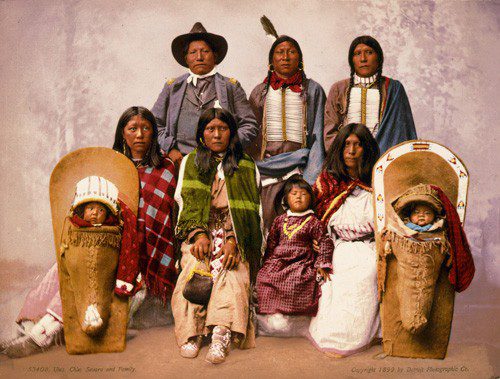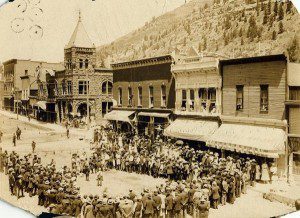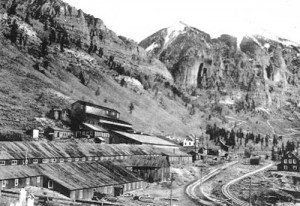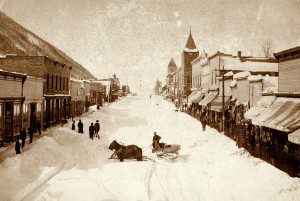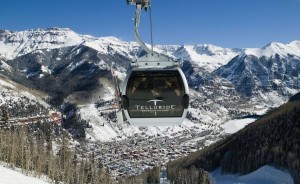Early History
Before the arrival of European settlers, the Ute Indians inhabited and explored the high San Juan Mountains, including the region around present-day Telluride, mainly during the summers. The Spanish explorers entered the San Juan region in the late 1700s, marking the first European contact in the area. Initially, the only Europeans in the region were trappers and a few adventurous explorers.
The mining camp of Columbia, established in the 1870s, became the first settlement in the area. It was not until 1875 that John Fallon made a significant mineral claim called the Sheridan in Marshall Basin, located above the present-day Telluride.
Due to postal confusion with a mining town named Columbia in California, the settlement changed its name to Telluride in 1887. The name Telluride has various origin theories. Some believe it was named after the element tellurium, which is often found in association with silver and gold in certain ores, although ironically, it is not found in the Telluride area itself. Others speculate that it originated from the phrase "to-hell-you-ride!," reflecting the lively and rowdy character of the booming town in the 1880s, with its bustling gaming parlors and infamous brothels. In 1887, a local newspaper humorously noted the contrast between the number of churches and saloons in neighboring Ouray and Telluride.
Following the name change, Telluride experienced a mining boom, becoming one of the richest mining areas in Colorado and the entire United States during that era. The mountains surrounding Telluride are now riddled with an extensive network of over 800 miles of tunnels, a testament to the extensive mining activities that took place in the area.
City of Gold
By 1890, Telluride had transformed from a modest mining camp into a bustling international town with a population of 5,000 residents. The arrival of the Rio Grande Southern Railroad in that same year further facilitated the town's growth. People from various parts of the world, including Italy, Austria, Ireland, and Finland, flocked to Telluride, adding to its diverse and cosmopolitan character.
During this period, the town experienced a rapid expansion in housing and infrastructure. Lots, which were sold for a mere $1 in 1881, were developed into a mix of dwellings, ranging from simple wooden miners' shacks to opulent Victorian mansions belonging to the mine owners. The vibrant Main Street boasted a lively scene, lined with a variety of establishments such as shops, livery stables, saloons, and gambling halls.
Following the silver crash of 1893, the town transitioned into a "gold boom" era, which sustained Telluride's vibrancy. Despite the economic shifts, the community continued to thrive with a rich social life. Dances, plays, and marching bands were common occurrences, adding to the lively atmosphere. The infamous Popcorn Alley, named for the constant opening and closing of doors in its bordellos during the night, remained a symbol of Telluride's spirited nightlife.
In 1895, the New Sheridan Hotel became a pride of Telluride. It rivalled Denver's renowned Brown Palace Hotel in terms of cuisine and service. Notable personalities, including presidential candidate William Jennings Bryan, delivered speeches from the hotel's balcony. Renowned figures such as Lillian Gish and Sarah Bernhardt were among the many celebrities who chose to stay at the New Sheridan. The adjacent Sheridan Opera House, constructed in 1914, served as both a 200-seat theater and a dance hall, further enriching Telluride's cultural scene.
Telluride's allure attracted a mix of notable and notorious individuals. It was in Telluride that Butch Cassidy, the infamous outlaw, began his bank-robbing career at the San Miguel National Bank in 1889, leaving a mark on the town's history.
Telluride's growth from a humble mining camp to an international town with a diverse population was remarkable. The town's vibrant Main Street, diverse housing, lively social scene, and prominent establishments like the New Sheridan Hotel and Sheridan Opera House all contributed to Telluride's captivating history and its status as a sought-after destination for both renowned figures and adventurers seeking their fortune in the Wild West.
Boom & Bust
Despite the initial prosperity brought by mining, the fortunes of Telluride took a downturn in the early 1900s. Diminishing mining profits and labor strikes dealt a blow to the industry, leading to a decline in the town's economic stability.
By 1930, the impact was evident as the Bank of Telluride closed its doors and the population dwindled to a mere 512 residents. The once-thriving mining community faced significant challenges and struggled to sustain its livelihood.
In 1953, the Idarado Mining Company emerged as a major player in the region. They acquired and consolidated all the mines in the area, creating a vast network of tunnels that spanned approximately 350 miles. This consolidation aimed to streamline operations and optimize mining activities in the Telluride area.
The closure of the Silverbelle brothel in 1959 marked the end of an era, as the town bid farewell to one of its infamous establishments. Over the years, the Telluride area had yielded substantial amounts of gold, silver, copper, lead, and zinc. However, the profitability of these mining operations steadily declined, and by 1978, they became economically unviable, leading to the cessation of mining activities.
The decline of mining in Telluride had a significant impact on the community and its economy. Yet, the town's resilience and ability to adapt would lead to a new chapter in its history, one centered around the discovery of the recreational opportunities provided by its natural surroundings.
Discovery of 'White Gold'
The discovery of the "white gold" brought a remarkable transformation to Telluride, revitalizing the town and restoring its prominence. Initially, the abundance of snow was disregarded by the miners, as it posed challenges to their mining operations. However, this very snow became the catalyst for Telluride's resurgence.
In 1968, a Beverly Hills entrepreneur named Joe Zoline arrived in Telluride with an ambitious vision of creating a winter recreation destination that would surpass all others. At that time, Telluride was facing decline, with businesses closing down and the younger generation migrating to urban areas in search of opportunities. Zoline's arrival was met with open arms by the community, who recognized the potential of his plans to breathe new life into their beloved town.
Zoline's vision for Telluride as a premier winter recreation area sparked a renewed sense of hope and enthusiasm among the locals. The once-dying community embraced the opportunity to reinvent itself as a destination for winter sports and outdoor activities. The town's infrastructure and amenities were revitalized, catering to the needs and desires of winter enthusiasts.
The arrival of Zoline and his dedication to transforming Telluride into a winter paradise marked a turning point in the town's history. With the newfound focus on winter recreation, Telluride began attracting visitors from far and wide, injecting vitality and economic prosperity back into the community.
The recognition of the value of snow and the realization of its potential as a tourism asset helped reshape Telluride's destiny. The town's ability to adapt and embrace the opportunities presented by winter recreation contributed to its enduring appeal as a destination for outdoor enthusiasts and adventure seekers.
The discovery of the "white gold" in Telluride, represented by the abundant snow, became a pivotal moment in the town's history. It not only revitalized the community but also attracted visionary individuals like Joe Zoline, who saw the untapped potential of Telluride as a premier winter recreation area. Through their collective efforts, Telluride underwent a remarkable transformation, cementing its reputation as a sought-after destination for winter sports and outdoor activities.
Skiing and Festivals
The introduction of skiing to Telluride can be credited to the Swedes and Finns, who brought this Scandinavian sport to the area. While some engaged in skiing purely for the joy of it, others saw it as a convenient way to reach their preferred bordello quickly. However, skiing truly began to gain popularity as a sport in the 1930s.
During this time, the Ski-Hi Ski Club played a significant role in promoting skiing in Telluride. They operated a small run with an unsteady rope tow, providing members with the means to enjoy the sport. As interest in skiing grew, it paved the way for the official opening of the Telluride Ski Area on December 22, 1972. The ski area boasted five lifts and a base facility, becoming a focal point of the town's renewed prosperity.
The establishment of the ski area brought about a boom in Telluride, rejuvenating the local economy and sparking a renewed sense of enthusiasm among residents and visitors alike. This newfound energy extended beyond the winter season and spilled over into Telluride's vibrant summer months.
In the following summer, Telluride witnessed the emergence of its first festivals, capitalizing on the town's newfound popularity. The Bluegrass, Hang Gliding, Chamber Music, and Film Festivals all made their debuts, adding to the town's cultural richness and providing a platform for celebration and entertainment.
The convergence of skiing and the introduction of festivals marked a turning point in Telluride's history, positioning the town as a destination for both winter sports enthusiasts and those seeking cultural experiences. The combination of outdoor recreation, scenic beauty, and vibrant events solidified Telluride's reputation as a place where both winter and summer thrive, attracting visitors from near and far.
A Bright Future Ahead
In 1975, the Coonskin Lift was constructed, creating access to the ski area directly from the Town of Telluride. In 1979, Ron Allred and the Benchmark Corporation of Avon, Colorado, purchased controlling interest in the ski area, and the mountain's real growth began: the regional airport was completed in 1985; the Sunshine Express high-speed quad chairlift was constructed for the 1986-87 ski season; a luxurious hotel and spa, The Peaks Resort & Spa (formerly the Doral Hotel) was opened along with the Telluride golf course in the Mountain Village in 1992. These amenities began to attract a much more upscale clientele to Telluride. By the turn of the century, Telluride and Mountain Village had become two of the most desirable places to live in all of America.
After mining's boom and bust cycle and an "off season" that once seemed permanent, Telluride is thriving again. Today, as one of the premier summer and winter resorts in the country, Telluride has a proud heritage, a diverse population, and exceptional skiing terrain; and it has become known as a cultural mecca, the "Festival Capital of Colorado." This Victorian-era community is one of only fifteen National Historic Landmark Districts in Colorado, the highest such designation awarded by the National Park Service. Everywhere in and on the mountains around town one can see and feel the rich history since great effort has been expended to preserve the architectural and cultural character of the area..
Newspaper and magazine articles consistently describe Telluride in glowing prose and have created an international awareness of the resort, but despite its recent popularity, Telluride has been able to retain its old-time, small-town feel. Locals feel this is the unique factor which ensures Telluride's future success. "We are on our way to making Telluride the best resort in North America," said Jim Wells, retired president of Telski, in a press release. "Not the biggest, but the best........."
Need more info? Contact Ray: (970) 729-2278 | Rachel: 970-708-9619


